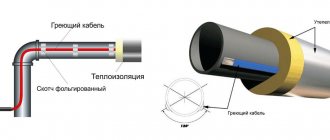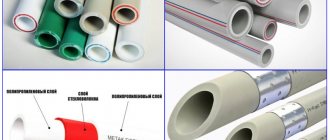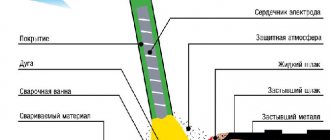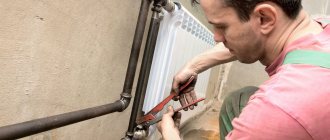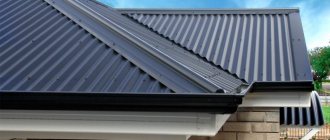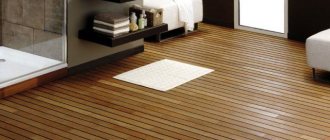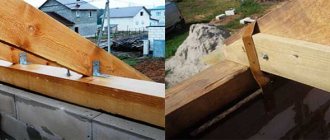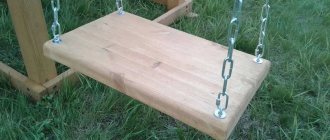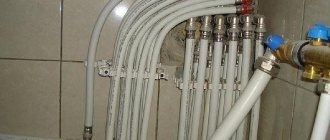In everyday life, laying pipelines inside or outside residential buildings is impossible without securing them to the surface of various types of building structures, walls, and floor slabs of houses. To do this, they usually use metal steel pipe clamps, as well as plastic products in the form of clips and other elements of various sizes.
If plastic fasteners have limited areas of application, then metal clamps, due to their design and dimensional diversity, are capable of solving a much wider range of problems. To make the optimal choice of pipe fasteners, you should know all the existing types of clamps supplied to the retail chain; it is useful to study the methods of their installation.
Fig.1 Tape and wire clamps according to GOST 28191-89
Fastening clamps and materials for their manufacture
A clamp is an element curved along the circular profile of a pipe, which contains details for fixing it to the pipe shell or the surface of the supporting structures.
It is clear that the fastening clamp must ensure reliable fixation of the pipeline in any position. Sometimes less rigid fasteners are required if the pipeline line has a high temperature coefficient of linear expansion (elongation).
Steel, due to its low cost, is more often used than other materials for the manufacture of metal fasteners. Thanks to its physical strength, rigidity, and flexibility, it is able to withstand high loads for a long period. To avoid corrosion, types of steel with a zinc or chrome coating are usually used.
In addition to steel, clamps are often made from corrosion-resistant materials: stainless steel, copper, brass, bronze, soft duralumin.
Rice. 2 Staples according to GOST 24193-80
Related article:
Distance between fastenings of polypropylene pipes - table by diameters . A separate article describes in detail the methods of fastening polypropylene pipes, types of clamps and clips, and also provides a table of permissible distances between fasteners.
General information
In order to ensure the normal level of water at the outlet occurs according to all the rules, it is necessary to observe some important factors:
IMPORTANT
It is extremely important to correctly carry out the expansion to which an additional unit of sanitary equipment will be connected. This also includes the formation of a new contour. For both, you will need a clamp for tapping into the water supply. And in order to maintain the strength of the connection for as long as possible, it is necessary to select the correct shaped element, and then correctly install it.
They resort to clamps when it becomes necessary to cut into the water supply. Such measures are necessary when carrying out renovation work in the apartment, as well as replacing the location or communications. The latter occurs if it is impossible to slow down the incoming water flow or there is no shut-off element.
REFERENCE
Insertion is performed for various purposes. For example, public main-type water supply pipelines also require the use of a clamp. But here it is important to know that this kind of action is not allowed for independent optimization or modernization. Appropriate permission from the authorities is required, otherwise, unauthorized insertion is punishable by administrative and financial liability.
Below are specific common cases in which tapping is necessary:
A new water intake point needs to be connected. (For example: it could be a household machine - washing or dishwasher)- It is necessary to launch the latest installed water consumers. (For example: for a jacuzzi)
- Water pipes are being replaced. At the end of their service life, pipes become unusable, therefore, such measures are necessary. This also includes cases when work is being carried out on the necessary modernization of the SV.
- A similar detail may be required when remodeling a living space, where there will be a complete relocation of bathtubs, faucets, sinks, etc.
- The bathroom will be combined or, conversely, separated.
Clamps for fastening metal and steel pipes - varieties
Since the clamps are made of steel, the sharp and hard edges of which can damage the polymer pipeline and do not provide a tight fit to the pipe shell, they are often equipped with rubber seals.
For fixing to pipes in clamp assemblies, bolts with nuts and special clamping units are used.
Clamps are attached to elements of building structures using screws and dowels, to nuts and threaded bolts, and by welding.
Snap-on (staples)
The design of cap clamps is given in GOST 24193-80; the document states that they are intended for fixing glass pipelines.
Structurally, the metal clamp for fastening pipes is made in the form of a semicircular bracket with bends along the edges, which have two through holes for fastening with screws or bolts.
The sizes of clamps for cap-type pipes are designed for their nominal diameter of 40, 50, 80,100, 150 and 200 mm.
In everyday life, these varieties can be used to secure 40 mm water pipes and 50 mm sewer pipes.
It is clear that in the retail chain you can find a wide range of metal brackets of a similar design in a wide range of nominal diameters that have nothing in common and are not regulated by the given state standard.
Fig. 3 Types of clamps according to GOST 17679-80.
Lightweight (loop)
The designs and dimensions of lightweight clamps are given in GOST 17679-80, which states that they are intended for securing pipeline and cable lines.
Almost all products are plates of metal of various profiles curved in the form of a round loop.
The internal diameter of the clamp loops is related to their design and ranges from 3 to 155 mm.
It is worth noting that lightweight fasteners are often made of St25 steel with zinc, cadmium coating and surface chromating.
Another material for their manufacture is stainless steel grade 12Х18Н10Т with chemically passive protection.
Also, coated metal pipe clamps are made from soft duralumin alloy grade D16AM with an anodic-oxide protective coating and chromate plating.
U-shaped
The design and dimensions of these products are given in GOST 24137-80, where they did not come up with another name other than just clamps. Products in the form of a horseshoe are made of steel rod with metric threads at the ends with zinc and chrome coating. They are designed for fastening pipelines with diameters from 14 to 540 mm.
Rice. 4 U-shaped types of clamps according to GOST 24137-80
Clamping
Specifications for clamping clamps (ties) are given in GOST 28191-89. In essence, they are not fastening pipelines to various structures, but serve to connect their sections (sleeves) to each other.
The following types of clamps are produced (Fig. 5), which are also called tape clamps:
- with a worm, light and heavy varieties with diameters from 8 to 160 mm and above (type 1);
- narrow with bolts of two different designs with diameters from 6 to 120 mm for the first design and from 60 to 350 mm for the second (type 2);
- wide with bolts with diameters from 20 to 80 mm (type 3).
Working with polymer reinforcement
It is even easier to insert into a polymer pipe. One of the methods does not require complex and most precise cutting of the pipeline. This is especially true when it is necessary to insert plastic elements of large diameters, which can be deformed under the influence of the insertion.
Insertion with pipe installation
To implement this method, you must first purchase a piece of pipe equipped with a pipe from a hardware store. The diameter of the workpiece must correspond to the cross-section of the water supply pipe.
From the purchased blank, a pipe is cut out in such a shape that one of its ends is equipped with a “half-pipe” type element, the main task of which is to ensure the overlap of the future insertion site
The manufactured blank will create, as it were, a second wall of the pipe. In the workpiece fixed on the pipe, a hole is drilled with a core drill, the diameter of which corresponds to the size of the pipe.
Liquid silicone sealant is applied to the inner surface of the mounted flange. The area around the hole is covered with the same composition, not reaching the cut line by 1 cm. The prepared flange is mounted on the pipe.
To tighten the edges on both sides, two additional fasteners are used. They should be tightened very carefully so as not to squeeze the sealant out from under the flange. The remaining glue that has come out is removed with a napkin.
If you have to make a connection on a plastic pipeline, the system pressure of which is minimal, you can safely use wide construction tape instead of a clamp.
Installation of adapter and saddle
For a sealed and at the same time quick connection of the pipeline, it is convenient to use ready-made elements:
- Adapters – used for inserting pipes D 100-110 mm.
- Saddles - chosen for inserting thin pipes D 32-40 mm.
The saddles are two-part crimp structures that are convenient to install if you need to tap into an unplugged system.
There are modern models of the device on sale, equipped with a heating coil and a cutting cutter with which a hole is made.
To set the required accuracy of welding parameters, when carrying out the procedure, it is necessary to focus on the bar code located on the body of the part
Cutting into a pipe using an adapter is quite simple. The work is carried out in several stages:
- If the pipe is connected to communications, shut off the water in the system.
- Use an electric drill equipped with a crown to make a suitable hole in the desired location.
- Install the adapter onto the prepared area, not forgetting to lay a soft rubber seal.
- Tighten the structure with bolts.
If the design of the embedded element does not provide bolts, construction sealant is used for fixation. To do this, the composition is applied to a degreased surface. The nut is carefully tightened, and any excess product that comes out is removed.
This article is devoted to the technology of inserting pipeline branches into a plastic water main, which we recommend that you read.
Plastic clamps for fastening pipes
Although polymers have much less strength than steel, due to some of their operational properties, in many cases they cope with the task of holding pipes no worse. They are distinguished primarily by corrosion resistance, elasticity and flexibility, a much more aesthetic appearance, which is perfectly suited to polymer pipelines.
The following main types of polymer (polyvinyl chloride, PVC) clamps are found in the retail network:
Clips. A plastic pipe clamp in the form of a clip is attached to the wall on a dowel with a screw, after which a pipe is inserted into it. Due to the flexibility and plasticity of the clip, it is firmly held in the fastener. Clips are indispensable when fastening polypropylene heating pipes laid along walls and approaching radiators. Paired models are in high demand, designed for the simultaneous attachment of two 25 mm or 32 mm pipeline lines.
Rice. 9 Polymer PVC and polypropylene clips and snap clips
Related article:
Replacing pipes in the bathroom and toilet - choice of pipe material, tools, installation methods . It is possible that before installing a pipe box in the bathroom, you also need to replace old pipes with new ones, and you can read how this is done in a separate article!
Snap clips. When installing pipelines, where their more reliable fixation is required, clips equipped with an additional element in the form of a latch are used. Usually they are used to fix 50 mm and 110 mm sewer pipelines.
Clamps with screw. These products have a similar design to metal ones and consist of two semicircular brackets connected by bolts, one of which is equipped with a self-tapping screw for screwing into a wall with a dowel.
Brackets with dowel. In appearance, it is a round-shaped clamping clamp with a flat outer section of the body for tight fixation on the supporting surface. Instead of tightening with a bolt and nut, it uses one screw that passes through the walls of the clamp and is fixed in the wall with a dowel.
Rice. 10 Plastic screw fasteners and dowel brackets
Fastener placement rules
There are the following distance standards given in the construction standards SN 408 (instructions for the design and installation of water supply and sewerage networks made of polymer pipes). Some of its and other provisions for the most commonly used household communications:
- If pipes made of PP polypropylene or low-density polyethylene (HDPE, HDPE) are used to supply cold water, the distance between them when installed horizontally should not exceed 550, 650 and 750 mm, respectively, for 20, 25 and 32 mm diameters.
- For polypropylene 25 mm and 32 mm pipelines, most often used in heating lines, the distance between supports for horizontal installation should be on average 600 or 700 mm, respectively, in the temperature range from 60 to 80 ° C.
- For medium-heavy PVC pipes with a diameter of 50 mm when laid horizontally, the approximate distance between fastening points should be 600 mm.
- When hanging a horizontal 110 mm medium-heavy pipeline, the approximate distance between the supports is taken to be 1100 mm.
- With a vertical arrangement of pipes made of PP polypropylene, PVC polyvinyl chloride and HDPE low-pressure polyethylene, the following standards for distances between supports for a working environment with a temperature of 30 ° C are accepted: - for the 32nd pipe - 1000 mm; — for the 50th — 1500 mm; — for the 110th — 3500 mm.
- Additional fastening of pipes should be done at their bends, that is, at the points where the curved section has the least rigidity.
- All supports should be placed at the sockets of horizontal pipelines and under them when they are laid vertically.
Required space between support points according to SNIP
A suitable distance between pipe support points is an important characteristic for the operation of the system. The points where the fastenings are installed make it possible to evenly distribute the existing load and reduce possible stress as much as possible. When laying heating mains, it is necessary to successfully distribute the temperature load.
The characteristics given in the SNiP tables contain requirements for the permissible free space between fixed supports, taking into account the purpose of the system. This data is necessarily included in tables, which significantly simplify the calculation of the system. Do not forget that the table does not contain recommended data, but a specific distance corresponding to SNiP, at what distance, what kind of fastenings and how many should be installed.
SNIP data
The choice of suitable holders directly depends on the characteristics of the mounted system and the level of future load on the elements used. Free placement of the pipeline is required where expansion effects due to high temperature are possible. Suitable fastenings allow the expanding elements to move freely when heated, but keep the system well on the wall surface.
Installation of screw metal clamps under dowels
To carry out the work, you will need a hammer drill with a concrete drill, a building level (preferably long), a tape measure, a screwdriver, a hammer, and plastic dowels, if they are not included in the clamp set.
Installation of fasteners to the wall is carried out in the following sequence:
- First, measure the length of the pipe and draw a line on the wall with a pencil corresponding to its location and length. If the pipeline is used in gravity heating systems, the required slopes must be observed.
- Next, mark the fasteners. Knowing the distance between the supports, the measured pipe section is divided by their number and the exact distance between the fastening elements is found out in order to evenly distribute the pipe fixation points along the wall.
- At the marks, through holes are drilled using a hammer drill with a drill of the appropriate diameter and dowels are driven into them.
- Screw a clamp with a screw into each hole until it stops - this will ensure the straight position of the pipeline line.
- Place the pipeline in the clamps and secure it with a second mating bracket, tightening the threaded bolt with a Phillips or flat-head screwdriver.
Rice. 12 Stages of fixing two-element clamps
Briefly about the main thing
Plastic or metal fasteners are used to attach pipes to the wall.
There are two installation methods: floating with space for thermal expansion of the channel and rigid fixation.
There are 6 main groups of fastenings: clips, clamps, staples, brackets, hooks and clamps.
Criteria for selecting fasteners: size, length and weight of the pipeline.
Install clamps at points of junctions, turns, fittings, and on long spans, taking into account the recommended distance.
Ratings 0
